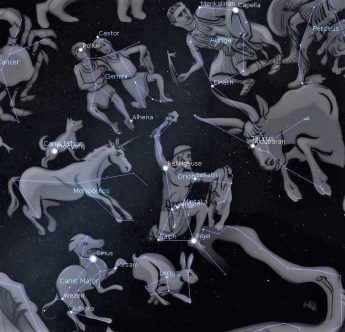This Week’s Sky at a Glance, 2023 Dec. 23 – Dec. 30
This Week’s Sky at a Glance, 2023 Dec. 23 – Dec. 30
As we approach the end of the year, step outside some clear evening and take a look around the sky. This time of year many of the brightest stars are at their best when you face south. Halfway up the sky is the slanted line of three stars that forms Orion’s Belt. Above it are the shoulders of the giant hunter, marked by reddish-orange Betelgeuse and Bellatrix to its right. Below, blue-white Rigel and Saiph are parts of Orion’s legs. The Belt points to the right at the V-shaped Hyades star cluster, anchored by orange Aldebaran, and to the compact, eye-catching Pleiades cluster; which together form the face and shoulder of Taurus the Bull.
To the lower left of the Belt is the night sky’s brightest star, Sirius, in Canis Major, the larger of Orion’s two canine companions. Bellatrix and dim Meissa, marking Orion’s head, form an arrowhead with Betelgeuse at the tip which points toward Procyon in two-star Canis Minor. Auriga and Gemini ride above Orion. Among these winter constellations are five of the ten brightest stars, with 12 more in the top fifty. Betelgeuse, like many red supergiant stars, varies in brightness over long periods as it expands and contracts.
Rather than make a New Year’s resolution that involves great sacrifice and likely won’t see February, why not start an astronomy project to learn the sky over the year. I recommend the RASC Explore the Universe program, which involves observing and describing or sketching objects using your unaided eyes, binoculars or a small telescope. The objects include constellations and bright stars, lunar features, the solar system, double stars, and deep sky objects like the hazy binocular nebula M42 below Orion’s Belt. By observing 55 of the 110 objects you could earn a certificate and a pin. For details, see https://www.rasc.ca/explore-universe or contact me.
This Week in the Solar System
Saturday’s sunrise in Moncton is at 7:59 and sunset will occur at 4:37, giving 8 hours, 38 minutes of daylight (8:01 and 4:45 in Saint John). Next Saturday the Sun will rise at 8:01 and set at 4:42, giving 8 hours, 41 minutes of daylight (8:03 and 4:50 in Saint John).
The Moon passes near the Pleiades this Saturday evening, and the Long Night Full Moon occurs on Tuesday. Besides being the full moon nearest the winter solstice it is also the one farthest north of the ecliptic this year, taking more than 17 hours to travel from northeast to northwest. Saturn is best seen in the early evening, setting around 9:30 midweek. On Thursday evening telescope users can watch Jupiter’s moon Europa disappear behind the planet at 8:55 and reappear at 11:16, and then disappear into Jupiter’s shadow four minutes later. Venus is slowly moving sunward but it will remain in the morning sky throughout the winter. Mercury and Mars are too close to the Sun for morning observing.

